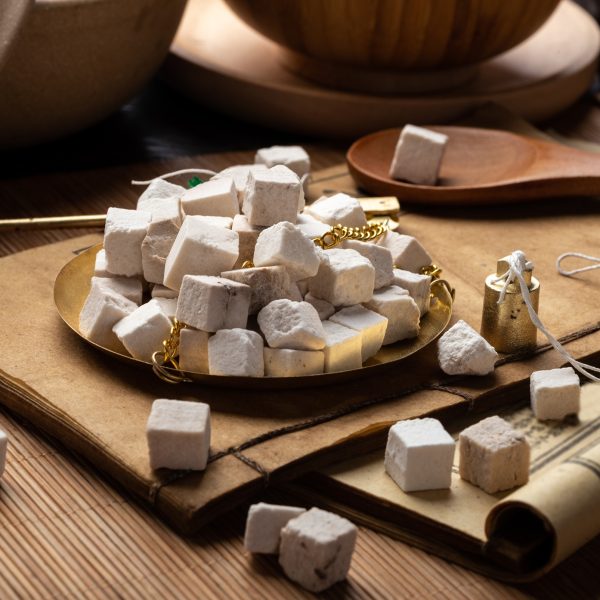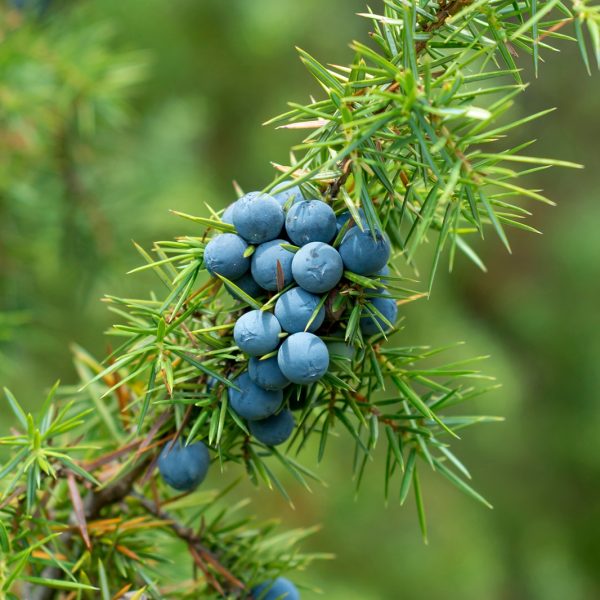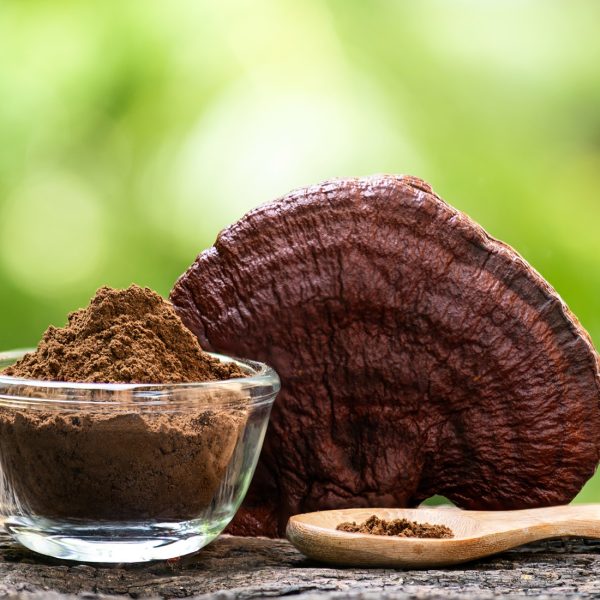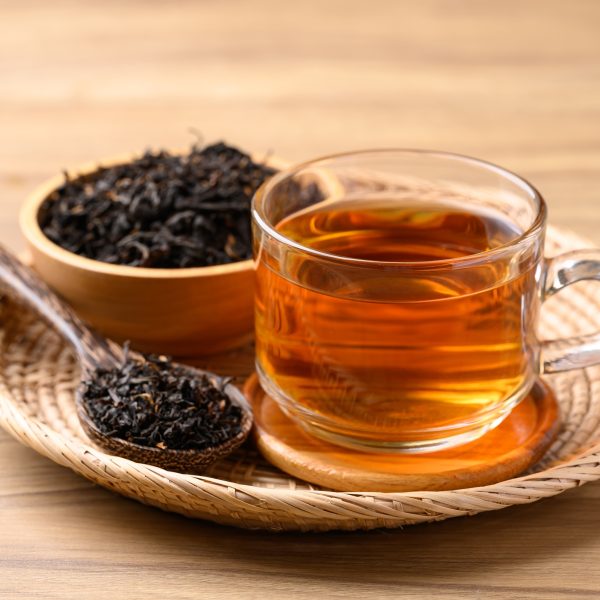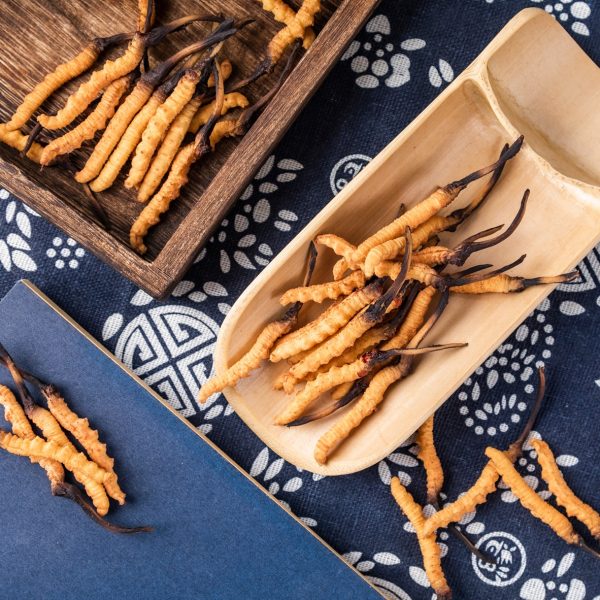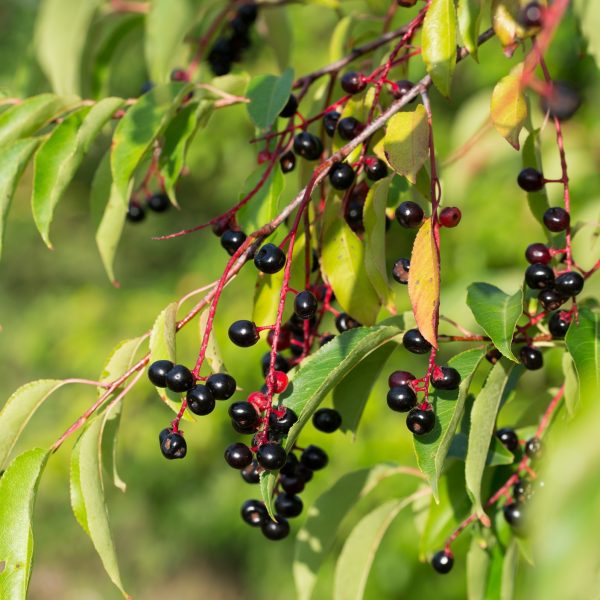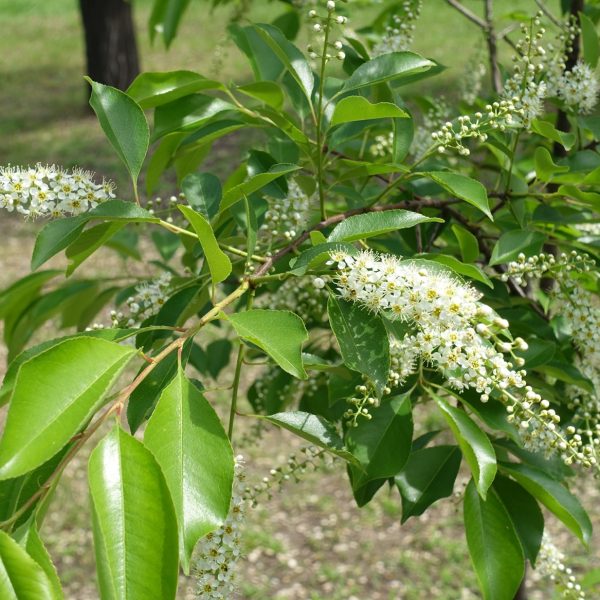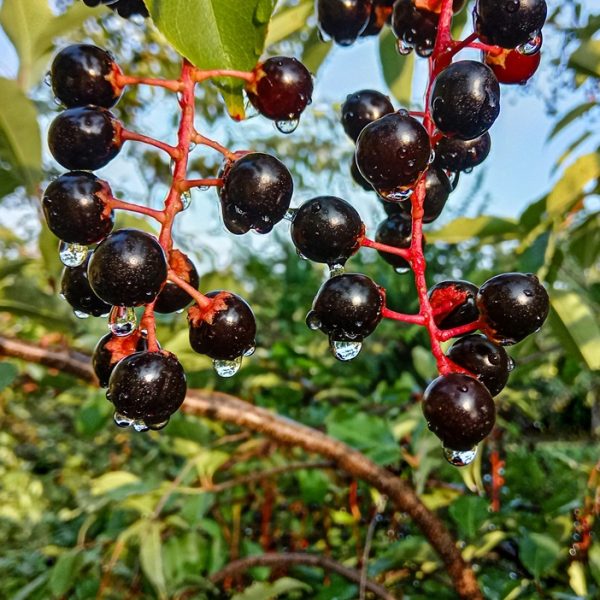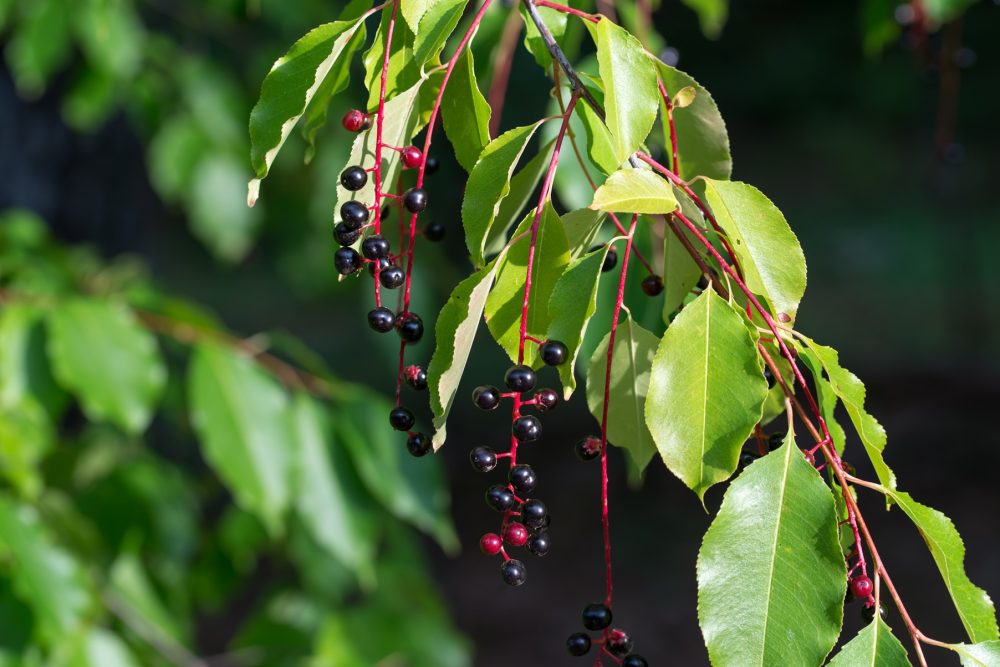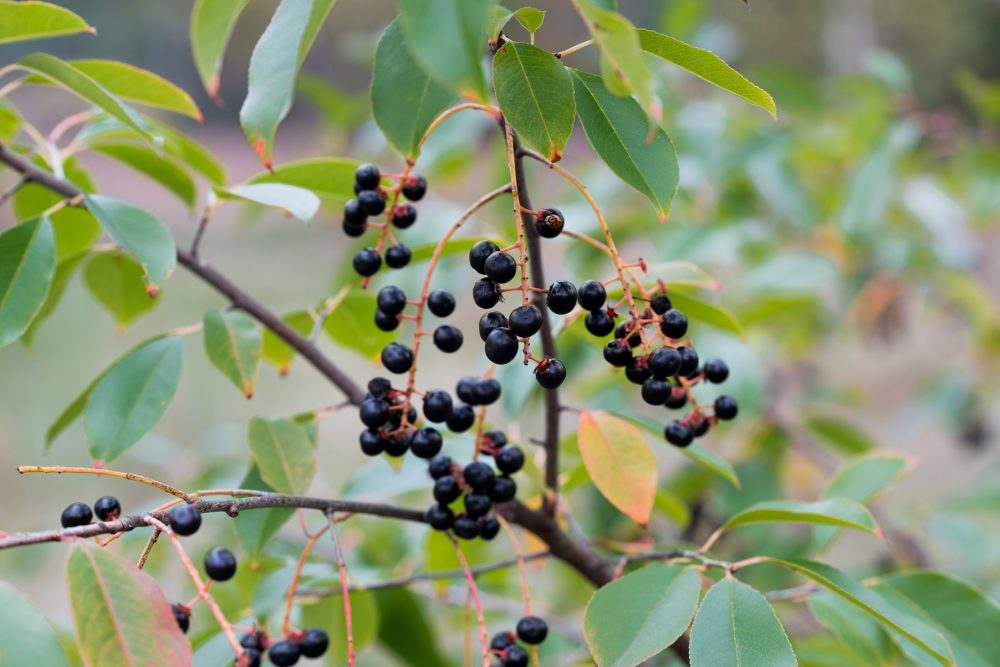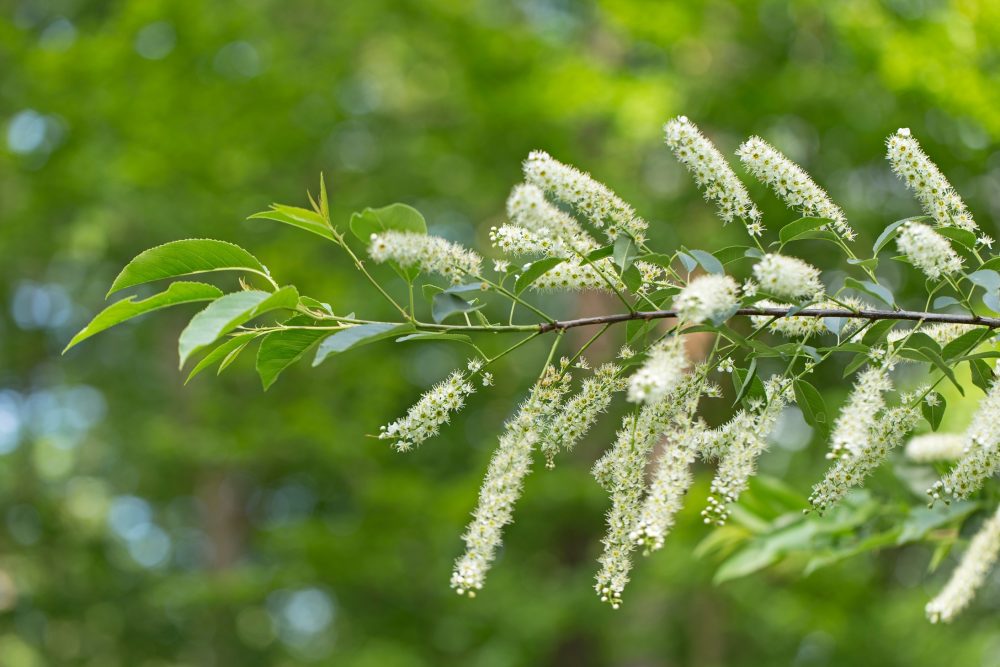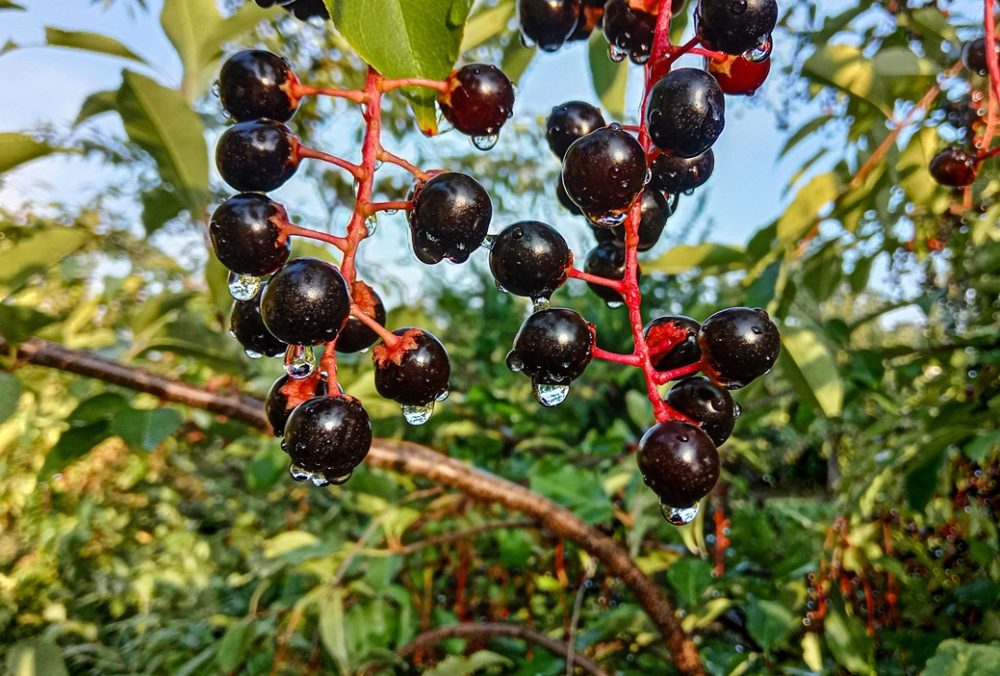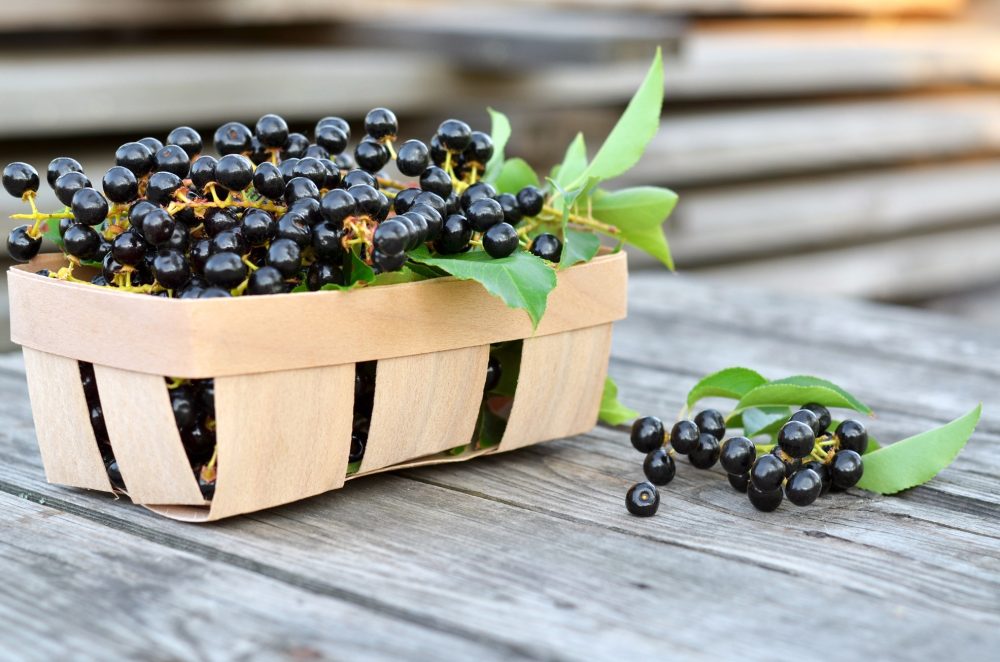-
How does it feel?
The aroma of wild cherry bark is one with woody, slightly sweet notes and a distinctive almond smell due to its cyanogenic glycosides. The astringency of wild cherry can instantly be felt on the tongue focusing the attention on this sensation whilst its relaxing, sedating effects on the breath and heart move through the body in a more subtle, yet powerful, manner once awareness of this rises to consciousness.
-
What can I use it for?
The most common use of wild cherry is for the type of dry, irritable, unproductive cough that may follow a chest infection, in which the cough no longer has any therapeutic value in promoting recovery or restoration of health, instead depleting the person’s strength, potentially causing pain and resulting in disturbed and unrestorative sleep, thus further contributing to exhaustion (1,2).
Wild cherry may also be used for the persistent cough of chronic bronchitis or that caused by increased irritability of the airways, and in cases of asthma when attacks are seen to typically be triggered by nervousness (3,4,5).
In children, it has a role to play in the treatment of spasmodic conditions, such as croup and whooping cough, however the latter is a serious condition and professional medical advice should be sought promptly (3,4,6,7).
-
Into the heart of wild cherry
In his 17th century book, The Complete Herbal, Culpeper classifies cherry as a herb of Venus associated with the realm of feelings and the element of water (8.9). This is consistent with folklore throughout Europe and the USA in which cherry is seen to represent love, romance and enticement (10).
Within Japanese culture, the fleeting nature of cherry blossom, often appearing suddenly and lasting only a brief length of time, is seen to symbolise the concept of ‘mono no aware’; that nothing in life is permanent and each moment should be appreciated despite a little melancholy at its passing (10,11).
Cherry blossom flower essence is indicated for those individuals whose hearts and minds have become closed and are unable to feel compassion. It is said to increase non-judgemental thoughts and acceptance of others as well as the ability to transcend negativity.
-
Traditional uses

Wild cherry (Prunus serotina) The consumption of wild cherry has been suggested to go back as far back as 6000 years ago during the early Neolithic era. More recently, around 400 BCE, its uses were mentioned by the Greek historian Herodotus (12). In the 17th century, Culpeper described its virtues as being “good for a cold, cough and hoarse-ness of the throat, mends the colour in the face, sharpens the eyesight, provokes appetite, and helps break and expel the stone…” (8).
Wild cherry was widely used and considered to be among the indispensable medicinal plants in the 19th century by both indigenous American peoples and early European settlers to the Americas. It is included in the Kings American Dispensatory, an Eclectic medical publication of the time that validated and recognised the knowledge and experience of the traditional plant medicine knowledge of the people native to the land (2,13). Here it is described as having a tonic and stimulating action on the digestive system, whilst sedating and calming the circulation and nervous system. Its main indications are considered to be the relief of mucous membrane irritation in the gastrointestinal, respiratory or urinary tracts.
It was said to be best suited to chronic conditions, in convalescence when it might be employed to lessen an irritating cough seen to be lessening the strength of the patient and to relieve pain or soreness in the chest (13,14,15). A cough formula from this time, Elixir Pinus Compositus, combined wild cherry bark with other plant derived ingredients including fresh white pine bark (Pinus strobus), balm of Gilead (Populus balsamifera), spikenard (Aralia racemosa), ipecac (Carapichea ipecacuanha) along with the addition of substances including chloroform, morphine and ammonium chloride, which was described as “an excellent preparation” (13,16).
It was traditionally used by women of the Cherokee peoples to alleviate labour pains and to promote a prompt delivery, although in modern herbal medicine its use during pregnancy, particularly during the first trimester, is cautioned due to its potential teratogenic effects (17,18). Peoples of the Penobscot Nation of the Northeastern regions of America traditionally used the boiled bark to treat diarrhoea (15).
In traditional Chinese medicine (TCM), wild cherry is considered to be indicated when there is ‘heart fire blazing’, manifesting as symptoms including agitation, nervousness, restlessness, rapid pulse or palpitations and the tongue is seen to be yellow coated with a red tip (19).
-
Traditional actions
Herbal actions describe therapeutic changes that occur in the body in response to taking a herb. These actions are used to express how a herb physiologically influences cells, tissues, organs or systems. Clinical observations are traditionally what have defined these actions: an increase in urine output, diuretic; improved wound healing, vulnerary; or a reduction in fever, antipyretic. These descriptors too have become a means to group herbs by their effects on the body — herbs with a nervine action have become the nervines, herbs with a bitter action are the bitters. Recognising herbs as members of these groups provides a preliminary familiarity with their mechanisms from which to then develop an understanding of their affinities and nuance and discern their clinical significance.
-
Traditional energetic actions
Herbal energetics are the descriptions Herbalists have given to plants, mushrooms, lichens, foods, and some minerals based on the direct experience of how they taste, feel, and work in the body. All traditional health systems use these principles to explain how the environment we live in and absorb, impacts our health. Find out more about traditional energetic actions in our article “An introduction to herbal energetics“.
-
What practitioners say
 Respiratory
RespiratoryAlthough wild cherry has a strong cough suppressing effect, it is important to consider that inhibition of the cough reflex does not treat the cause of the cough, such as a chest infection, and may be detrimental to recovery. Its use for patients with productive coughs may actively worsen the underlying condition (1,20). Its gentle, relaxing, antispasmodic actions are more indicated in those patients whose primary symptoms of respiratory infection are resolved, however they develop an ongoing irritating, spasmodic cough that depletes their strength, causes pain and disturbs sleep, further exhausting them, or in cases of chronic bronchitis, debilitates the patient (1,2,21).
Its pulmonary antispasmodic actions may also be useful in preventing and relieving the acute bronchospasm of asthma particularly for individuals in whom stress often causes breathlessness that may lead to an asthma attack (1,5). It is considered to be specific for tracheitis, an inflammation of the trachea that may follow bacterial or viral infection, however this is often a serious condition, particularly in children, and emergency medical attention should be sought without delay (3).
In cases of asthma, it is most useful where the tissues of the throat or lungs are irritated, producing a spasmodic cough along with whistling or wheezing in the airways (7,15,22). For this and other conditions such as irritable or chronic coughs it combines well with other soothing demulcent herbs such as coltsfoot (Tussilago farrara), liquorice (Glycyrrhiza glabra) mullein (Verbascum thapsus), marshmallow (Althea officinalis) or goldenrod (Solidago virgaurea), as well as other antispasmodic herbs with an affinity for the respiratory system, such as thyme (Thymus vulgaris) as a tincture, tea or throat pastille (7,17,21,22).
Digestive
Although the uses of wild cherry are predominately associated with conditions affecting the lower respiratory system, its long history of use for digestive complaints remains relevant in modern herbal practice today. Once again the indication is one of irritability or when symptoms such as indigestion, loss of appetite, chronic diarrhoea or irritable bowel symptoms are triggered by nervousness or anxiety (3,17,21).
Nervous
Wild cherry is considered to have a sedative action on the nervous system, relieving nervous excitability and may be used in times of prolonged irritation (6,21).
Cardiovascular
The sedative properties of wild cherry are also seen in its action of the cardiovascular system. It has been said to “relieve arterial excitement” (21), and may be included in a formula for an irregular heart beat (19). Along with fruits such as bilberry (Vaccinium myrtillus), grape and pomegranate, the juice of the cherries may be beneficial in cases of capillary fragility due to its high flavonoid content (23).
Inflammation of the eyes
Due to the high tannin content, an external topical preparation of a cold infusion of wild cherry bark can be used as a compress for wounds or acute inflammatory conditions of the eyes (20,21).
-
Research

Wild cherry (Prunus serotina) Phytopharmacological possibilities of bird cherry Prunus padus L. and Prunus serotina L. species and their bioactive phytochemicals
This 2020 study aimed to review evidence from in vitro and in vivo investigation of potential cardiovascular, antioxidant, anti-inflammatory, antimicrobial and antidiabetic actions of two species of cherry, P. serotina and P, padus including phytochemicals found in the flowers, fruit, leaves and bark of these species.
The high phenolic compound content of wild cherry was demonstrated to be directly related to both its antioxidant and vasodilating effects, which were synergistically increased by the triterpenes also present within wild cherry — suggesting potential benefits in many cardiovascular conditions. Both this study and previously published work by other authors indicate that the antioxidant activity is positively correlated with that of the flavonoid content. These polyphenolic compounds were demonstrated to be highest in the peel of the fruit however were also observed to be present in the leaf, flesh, fruit and bark of the tree.
Methanol extracts of the plant stem were found to contain compounds including anthocyanins, cyanogenic glycosides and flavonoids, which were shown to possess significant anti-inflammatory properties through strongly influencing the inhibition of nitric oxide production and cyclooxygenase-2 expression consequently seen to suppress inflammatory mediators. The study confirmed that the extract was effective at reducing inflammatory swelling in vivo as well as through in vitro conditions. This was combined with analgesic effects comparable to those of strong painkiller medications, such as tramadol, suggested to be through its action as a partial opioid agonist.
The potentially antibacterial effects of extracts from the seeds of wild cherry were demonstrated to be effective against a range of pathogenic bacteria including methicillin-resistant strains of Staphylococcus aureus. In contrast, the leaves and branches were shown to exhibit alpha-glucosidase inhibitory activity, which has been seen to be beneficial in the treatment of type 2 diabetes by modulating the increase of blood glucose levels (12).
Nutraceutical value of black cherry Prunus serotina Ehrh. fruits: Antioxidant and antihypertensive properties
This research from 2013 investigated the potential vasorelaxant and antihypertensive properties of the polyphenolic compounds contained in wild cherry fruit based on traditional usage in Mexico. Both an aqueous and alcohol extraction of these compounds were demonstrated to elicit the relaxation of vascular smooth muscle.
It was surmised that the vasodilatory effects of these extracts is likely to be a synergistic response between the quercetin glycosides along with phenolic compounds such as anthocyanins and proanthocyanadins, which have previously been seen to have antihypertensive properties. Laboratory studies involving induced hypertension in rats indicated that although significant reductions in systolic blood pressure were seen in the hypertensive rats, the control subjects with normal blood pressure who also received the extract had no change in their blood pressure. These results were considered sufficiently robust to include the consumption of wild cherry fruit as a functional food as part of a strategy for preventing and treating cardiovascular conditions such as hypertension (24).
Prunus avium L.; Phytochemistry, nutritional and pharmacological review
This review published in 2021 examined the phytochemical constituents of a species of cherry, P. avium, that may be used interchangeably with P. serotina by some practitioners. The chemical compounds including cyanidin 3-sophoroside, cyanidin 3-rutinoside, cyanidin 3-glucosylrutinoside, cyanidin 3-glucoside were seen to exhibit antioxidant, anti-inflammatory, antimicrobial, neuroprotective and diuretic actions in addition to demonstrating some cytotoxic, antigenotoxic and anti-cancer properties indicating its potential application to be treatment of many chronic disease states including inflammatory and cardiovascular conditions, diabetes, arthritis and cancer alongside its more frequent use in the treatment of irritable coughs and other spasmodic conditions affecting the lungs and lower respiratory tracts such as asthma and chronic bronchitis.
A review of the literature available indicated that the consumption of wild cherry was seen to decrease markers for oxidative stress and inflammation, reduced hypertension, decreased symptoms of arthritis, improved sleep and had a positive effect on exercise induced muscle pain and loss of strength in a significant percentage of human studies (25).
-
Did you know?

Wild cherry (Prunus serotina) The botanical name for this species of cherry, serotina, is derived from the Latin term ‘serotinus’ which translates as ‘coming late’; referring to the fact that in contrast to other species of cherry, wild cherry blossom appears much later in the season (26).
One of its less frequently used common names, rum cherry, is derived from it having been used by Appalachian settlers to flavour home produced or low quality rum and brandy to create a spirit known as cherry bounce (26).
Although toxic if consumed, due to the presence of cyanogenic glycosides, other parts of the wild cherry tree can be used for various external purposes. The leaves can be used to produce a green pigment suitable for dying wool or fabrics whilst the wood is prized among woodworkers for its close, straight grain, smooth finish producing a fine polish resulting in its use for high quality furniture and interior finishing (27).
The bark is said to be effective as a hair rinse to decrease tangling and make combing easier, particularly in combination with ragwort or nettle (Urtica diocia), and as an external remedy for cellulite (28).
Additional information
-
Botanical description
Wild cherry is a deciduous tree which typically grows to up to 30 metres in height depending on location and growing conditions. In the eastern parts of the USA it may reach heights of 38 metres with a truck diameter of over a metre, whilst south-western varieties tend to be smaller. Throughout Europe and in mixed forestry it is frequentlyy is seen as a shrub or under-story tree rarely exceeding a maximum growth of 20 metres in height (36,37).
The bark of young trees is smooth and a red-brown colour with clear pale or white lines running horizontally around the trunk and limbs of the tree, the inner bark releasing a pungent aroma of bitter almonds if scratched. As the trees age and mature the bark darkens to dark grey or black and roughens developing thick, irregular scaly plates (27,38).
Wild cherry has characteristically long, lancet-like pointed leaves with sharply serrated edges. These are a dark glossy green on the upper surface whilst much paler on the underside. The vein network is often poorly visible however fine hairs can be seen along the main vein of the leaf and pairs of tiny glands are apparent on the stem where this meets the base of the leaf (12,36,37).
Depending on location, climate and growing conditions, the flowers of the wild cherry trees generally open between late May or early June-time each year. These flowers are 8–10 mm in diameter and borne in cylindrical umbel-like racemes of between 6–15 cms long, each bearing around 30 flowers. These are hermaphroditic, bearing both staminate and pistillate reproductive organs with the same flower. Unlike the strong bitter fragrance of the bark, the flower has no aroma (12,36,37). The simple fleshy fruits containing a single pit, or stone, containing the seed, grow to around 8–10 mm in diameter and ripen to a dark purple-black colour during September (36,37).
-
Common names
- Wild cherry
- Black cherry
- Rum cherry
- Mountain black cherry
-
Safety
The majority of sources state that wild cherry should not be used during pregnancy due to the presence of the cyanogenic glycoside prunasin and concerns regarding the potential teratogenic effects on the developing unborn fetus (7,4,19,29). However, there is no evidence to suggest any safety issues regarding taking wild cherry whilst breastfeeding (3).
It is advised to be only taken as needed and prolonged use should be avoided. It should also be considered that inhibiting a cough is not generally beneficial in the case of a chest infection and it should be taken with caution, preferably under the guidance of an experienced medical herbalist (3,4,20,29).
The potential toxicity of prunasin, one of the active compounds within cherry bark, is significantly reduced in humans due to it being hydrolysed in the digestive tract and liver which results very low levels of hydrocyanic acid being slowly released and are easily detoxified by the human body, although cases of poisoning have occurred in livestock and in children having consumed the kernels, twigs or leaves (3).
-
Interactions
There is a theoretical interaction suggested by in vitro research that wild cherry may increase levels of drugs metabolised by the CYP3A4 pathway such as lovastatin (Mevacor), ketoconazole (Nizoral), itraconazole (Sporanox), fexofenadine (Allegra), triazolam (Halcion); however, this interaction has not been reported in humans (30,31,32).
-
Contraindications
Use of wild cherry is contraindicated during pregnancy and for prolonged use due to the presence of the cyanogenic glycoside prunasin (4,7,29).
-
Preparations
- Decoction
- Tincture
- Fluid extract
- Glycerite
- Syrup
-
Dosage
- Tincture (1:5 | 40%): 1–2 ml to be taken three times per day / 20–40 ml per week (6).
- Tincture (1:2 | 45%): 0.6–1.5 ml to be taken three times per day / 15–30 ml per week (6,14).
- Decoction: Pour one cup of boiling water over ½ to one teaspoon of dried bark and simmer for 10–15 minutes. Half to one cupful to be drunk three times a day (6,16).
- Syrup: 3–10 ml three times daily or as per manufacturer’s guidelines (29,33).
-
Plant parts used
Bark
-
Constituents
- Amino acids: Cyanogenic glycosides, the key constituent being prunasin (3,34,35)
- Terpenes: Triterpenoids including ursolic and oleanolic acids, limonene, phellandrene, sabinene and γ-terpinene (12,34)
- Polyphenols: Anthocyanins, flavonoids, catachins and tannins (12,34)
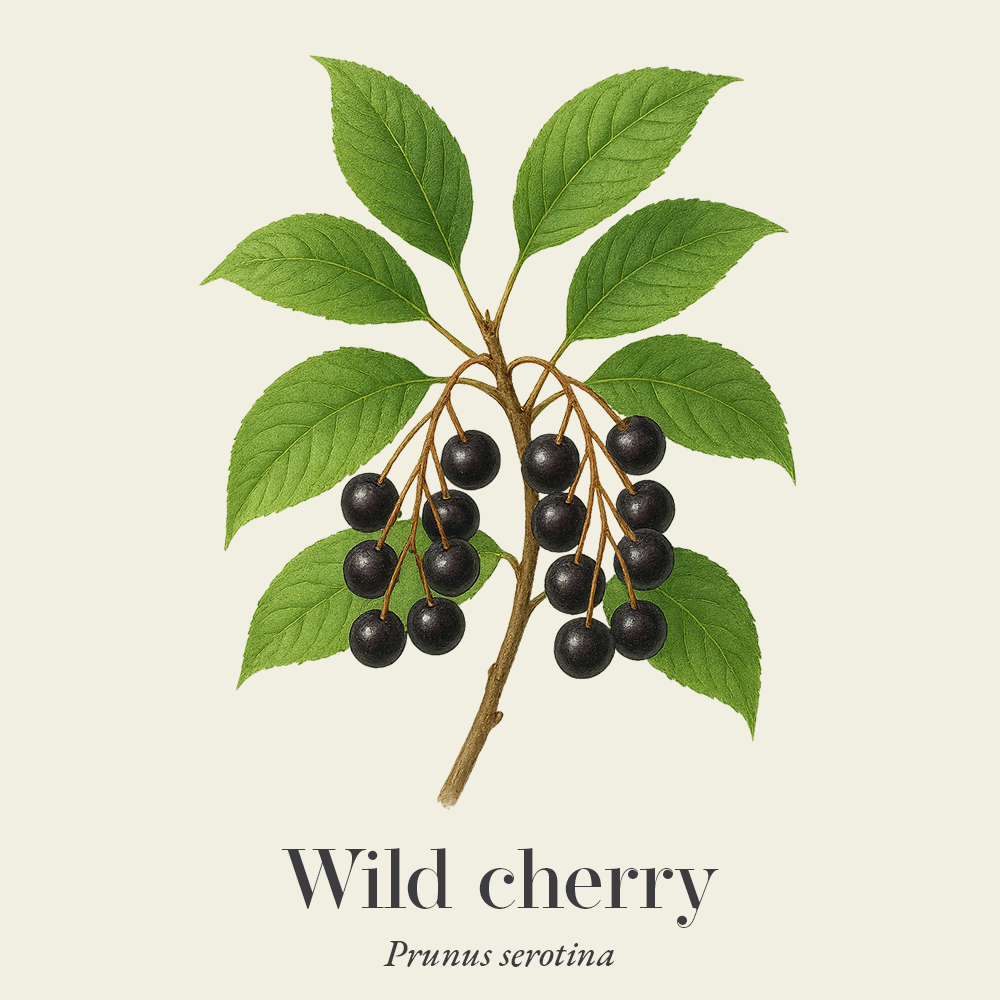
-
Habitat
Wild cherry, whilst originally considered native to North America, can now be found throughout much of the USA and was introduced to Europe for cultivation of its wood as timber (26,37,39). It grows naturally in uncultivated fields, forest edges and open woodlands (27). In the US it is considered a pioneer species, and a key species in secondary forest succession, being rapidly established in areas that have been clear cut for the timber harvesting industry providing both soil stability and shade cover as the forest floor regenerates (38,40).
-
Sustainability

Not currently on risk lists but complete data may be missing on the status of the species. Read more in our sustainability guide. Wild cherry (Prunus serotina) has most recently been assessed for The IUCN Red List of Threatened Species in 2018 and is listed as ‘Least Concern’. (41).
Throughout the Northern American states during the early 20th century, pioneer species such as wild cherry were seen to thrive due to policies of clear-cutting existing forests for timber harvesting and the increased presence of nitrogen created by industrialisation. For many years this abundance of prized and in-demand wood was seen to significantly benefit the timber industry. However, since the start of the 21st century the populations of wild cherry have been seen to diminish. Research into reasons why these previously dominant species appears to be in decline, and potential solutions to this are ongoing (40).
In contrast to this, wild cherry is currently considered to be one of the 100 most invasive non-native species in Europe. It’s spread through the temperate forested environments of northern-western European, particularly at times of forest regeneration or where there is high grazing pressure from local herbivores is seen to be competing for available resources with the indigenous flora of the regions (36,42).
Habitat loss and over-harvesting from the wild are two of the biggest threats faced by medicinal plant species. There are an increasing number of well-known herbal medicines at risk of extinction. We must, therefore, ensure that we source our medicines with sustainability in mind.
The herb supplement industry is growing at a rapid rate and until recent years a vast majority of medicinal plant produce in global trade was of unknown origin. There are some very real and urgent issues surrounding sustainability in the herb industry. These include environmental factors that affect the medicinal viability of herbs, the safety of the habitats that they are taken from, as well as the welfare of workers in the trade.
The botanical supply chain efforts for improved visibility (transparency and traceability) into verifiably sustainable production sites around the world is now certificated through the emergence of credible international voluntary sustainability standards (VSS).
Read our article on Herbal quality & safety: What to know before you buy and Sustainable sourcing of herbs to learn more about what to look for and questions to ask suppliers about sustainability.
-
Quality control
Herbal medicines are often very safe to take; however, their safety and efficacy can be jeopardised by quality issues. So, it is important to buy herbal medicines from a reputable supplier, from sources known to test their herbs to ensure there is no contamination, adulteration or substitution with incorrect plant matter, as well as ensuring that recognised marker compounds are at appropriate levels in the herbs.
Some important quality assurances to look for are certified organic labelling, the correct scientific/botanical name, and the availability of information from the supplier about ingredient origins. A supplier should be able to tell you where the herbs have come from, what contaminants are not in the herb, and what the primary compounds are.
-
How to grow

Wild cherry (Prunus serotina) Wild cherry is a relatively fast growing tree that needs to be located in a warm sunny location. It can be grown from both seeds or the shoots are seen on the roots or at the bottom of the main trunk of the tree (27,43). It will thrive in a well drained, loamy soil or limestone and benefits from the presence of some chalk in the soil although excess of this may result in it becoming pale. It normally first produces fruit at about ten years and may continue to do so for up to a 100 years in the wild producing a particularly heavy crop approximately every four years however, as with many other members of the Prunus genus, it is susceptible to honey fungus (27).
The flowers are insect pollinated, attracting a diversity of flies, beetles and species of bees including the honey bee. Although self-pollination has been evidenced, the resulting flowers failed to develop into viable seeds (26). If the intention of cultivating wild cherry is for the harvesting of the bark for medicinal use it should be coppiced on a 4–5 year rotation (43).
Harvesting
The majority of sources recommend harvesting the bark in Spring, before the opening of the first buds, when the cyanogenic glycosides are at their lowest levels. The bark should be stripped before drying (2,43). Although it is claimed by some that wild cherry bark does not store well and loses its medicinal properties within a year, others refute this and report that in their experience they have seen it to retain these qualities for over two years. As with all plant medicines this is best assessed through organoleptic observation of the plant matter and if a cold infusion of the bark produces a deep cherry aroma with a rich orange red colouration then the likelihood is that it has retained its medicinal actions (17,27,44).
-
Recipe

Wild cherry (Prunus serotina) Wild cherry cough relief syrup
An effective and palatable remedy for the relief of irritating coughs in children and adults. Not for use during pregnancy. Caution advised for use by individuals with high blood pressure, cardiac related oedema or congestive heart failure (Adapted from Aunty Aviva’s Cough Syrup blend) (7).
Ingredients
- Wild cherry bark – 1 part
- Angelica root – 2 parts
- Coltsfoot – 2 parts
- Mullein – 2 parts
- Marshmallow root – 2 parts
- Liquorice – 2 parts
- Thyme – 2 parts
- Anise seed – 2 parts
- Burdock root – 2 parts
- Boiling water
(Although the original recipe also contains slippery elm (Ulmus rubra) and lobelia (Lobelia inflata), these have been omitted due to potential sustainability concerns regarding slippery elm and the status of lobelia as a Schedule 20 practitioner only herb in some parts of the world including the UK).
How to make wild cherry cough syrup
- For each 30 g of the combined herb mixture, add one litre of boiling water and leave to steep for two hours.
- Strain the plant material and simmer the resulting liquid gently over a low heat until it has reduced to approximately 250 ml. Sweeten to taste with honey, sugar or maple sugar. Store in the fridge and use within two months.
- Dosage is 5 ml for children between 1–3 years per day, 10 ml for older children and up to 20 ml as needed for adults.
-
References
- Yarnell E & Abascal A. Spasmolytic Botanicals: Relaxing smooth muscle with herbs. Alternative and Complementary Therapies 2011. doi.org/10.1089/act.2011.17305
- Wood M. The Earthwise Herbal, Volume II: A Complete Guide to New World Medicinal Plants. North Atlantic Books; 2009.
- Mills SY, Bone K. The essential guide to herbal safety. Elsevier Health Sciences; 2004.
- Thomsen M. The Phytotherapy Desk reference: 6th Edition. Aeon Books; 2022.
- Green J. The Male herbal: The Definitive Health Care Book for Men & Boys.; 2007.
- Hoffmann D. Medical Herbalism: The Science and Practice of Herbal Medicine. Simon and Schuster; 2003.
- Romm AJ. Naturally healthy babies and children: A Commonsense Guide to Herbal Remedies, Nutrition, and Health. Springer Science & Business; 2003.
- Culpeper N. Culpeper’s complete herbal: A Book of Natural Remedies for Ancient Ills. Wordsworth Editions; 1995.
- Brooke E. A Woman’s Book of Herbs. The Women’s Press; 1992.
- O’Driscoll D, O’Driscoll D. Sacred Tree Profile: Cherry (Prunus serotina)’s magic, mythology, medicine and meaning – The Druids Garden. The Druids Garden – Spiritual journeys in tending the living earth, permaculture, and nature-inspired arts. Published April 17, 2022. https://thedruidsgarden.com/2019/06/23/sacred-tree-profile-cherry-prunus-serotinas-magic-mythology-medicine-and-meaning/
- Archive IST. Ancient Tales and Folk-lore of Japan: XXXIII. The Holy Ch… | Sacred Texts Archive. Internet Sacred Text Archive. Published 1918. https://www.sacred-texts.com/shi/atfj/atfj35.htm#page_202
- Telichowska A, Kobus-Cisowska J, Szulc P. Phytopharmacological Possibilities of Bird Cherry Prunus padus L. and Prunus serotina L. Species and Their Bioactive Phytochemicals. Nutrients. 2020;12(7):1966. doi:10.3390/nu12071966
- Prunus Virginiana (U. S. P.)—Wild Cherry. | Henriette’s herbal homepage. https://www.henriettes-herb.com/eclectic/kings/prunus-sero.html
- Bone K. A clinical guide to blending liquid herbs: Herbal Formulations for the Individual Patient. Elsevier Health Sciences; 2003.
- Bartram T. Encyclopedia of Herbal Medicine. Grace publishers; 1995.
- Cook WMH, THE PHYSIO-MEDICAL DISPENSATORY: A TREATISE ON THERAPEUTICS, MATERIA MEDICA, AND PHARMACY, IN ACCORDANCE WITH THE PRINCIPLES OF PHYSIOLOGICAL MEDICATION. WM. H. COOK; 1869. https://medherb.com/cook/cook.pdf
- Chevallier A. Encyclopedia of Herbal Medicine. Dorling Kindersley; 2000.
- Setzer WN. The Phytochemistry of Cherokee Aromatic Medicinal plants. Medicines. 2018;5(4):121. doi:10.3390/medicines5040121
- Easley T, Horne S. The modern herbal Dispensatory: A Medicine-Making Guide. North Atlantic Books; 2016.
- Hoffman D. Complete herbal. Element Books; 1996.
- Priest AW, Priest LR. Herbal medication: A Clinical and Dispensary Handbook.; 1983.
- Wood M. The Earthwise Herbal Repertory: The Definitive Practitioner’s Guide. North Atlantic Books; 2016.
- Stansbury J. Herbal Formularies for Health Professionals, Volume 2: Circulation and Respiration, including the Cardiovascular, Peripheral Vascular, Pulmonary, and Respiratory Systems. Chelsea Green Publishing; 2018.
- Luna-Vázquez F, Ibarra-Alvarado C, Rojas-Molina A, et al. Nutraceutical Value of Black Cherry Prunus serotina Ehrh. Fruits: Antioxidant and Antihypertensive Properties. Molecules. 2013;18(12):14597-14612. https://doi.org/10.3390/molecules181214597
- Hussain S, Javed M, Abid MA, et al. Prunus avium L.; Phytochemistry, Nutritional and Pharmacological Review. Hussain | Advancements in Life Sciences. Published December 31, 2021. https://submission.als-journal.com/index.php/ALS/article/view/910/662
- Marquis D A. Prunus serotina Ehrh. black cherry. Silvics of North America, 2, 1990 https://research.fs.usda.gov/silvics/black-cherry
- Prunus serotina Rum Cherry – Wild Cherry, Black Cherry, Wild Black Cherry PFAF Plant Database. https://pfaf.org/user/Plant.aspx?LatinName=Prunus+serotina
- Rose J. The herbal body book. Frog Ltd; 2000
- Brinker FJ. Herb contraindications and drug interactions: With Appendices Addressing Specific Conditions and Medicines. Eclectic Medical publications ; 1998.
- TRC Healthcare. NatMed Pro – NatMed Pro. https://naturalmedicines.therapeuticresearch.com/Home/ND?referer=natlinstituteofmedicalherbalists%2fintranet.urls
- Basheer L, Kerem Z. Interactions between CYP3A4 and Dietary Polyphenols. Oxidative Medicine and Cellular Longevity. 2015;2015:1-15. https://doi.org/10.1155/2015/854015
- Molden E, Spigset O. Frukt og baer–interaksjoner med legemidler [Fruit and berries–interactions with drugs]. Tidsskr Nor Laegeforen. 2007 Dec 13;127(24):3218-20. Norwegian. PMID: 18084364.
- Wren RC, Williamson EM, Evans FJ. Potter’s new Cyclopaedia of Botanical Drugs and Preparations. C.W. Daniel Company, Limited; 1988.
- Ganora L. Herbal constituents: Foundations of Phytochemistry : a Holistic Approach for Students and Practitioners of Botanical Medicine. Herbalchem Press; 2009.
- Pengelly A. The constituents of medicinal plants. CABI Publishing; 2021.
- Terwei A. Prunus serotina (black cherry). CABI Compendium. Published online January 7, 2022. https://doi.org/10.1079/cabicompendium.44360
- Phillips R, Grant S, Wellsted T. Trees in Britain, Europe and North America. Weidenfeld & Nicolson; 1978.
- Prunus serotina (black cherry):Go Botany. https://gobotany.nativeplanttrust.org/species/prunus/serotina/#:~:text=Facts,to%20flavor%20rum%20and%20brandy.
- Prunus serotina Ehrh. | Plants of the World Online | Kew Science. Plants of the World Online. https://powo.science.kew.org/taxon/urn:lsid:ipni.org:names:30010850-2
- Northern Research Station USDA Forest Service. Black Cherry: Evolution of a species. US Forest Service Research and Development. Published 2022. https://research.fs.usda.gov/treesearch/65782#:~:text=Abstract,to%20slow%20the%20species’%20decline.
- IUCN Red List of Threatened Species: Prunus serotina. IUCN Red List of Threatened Species. Published February 13, 2018. https://www.iucnredlist.org/species/61957524/61957527
- Pairon M, Petitpierre B, Campbell M, et al. Multiple introductions boosted genetic diversity in the invasive range of black cherry (Prunus serotina; Rosaceae). Annals of Botany. 2010;105(6):881-890. https://doi.org/10.1093/aob/mcq065
- Jones L. Self-Sufficient herbalism: A Guide to Growing, Gathering and Processing Herbs for Medicinal Use. Aeon Books; 2020.
- McDonald J. Wild Cherry Monograph — HerbRally. HerbRally. https://www.herbrally.com/monographs/wild-cherry

